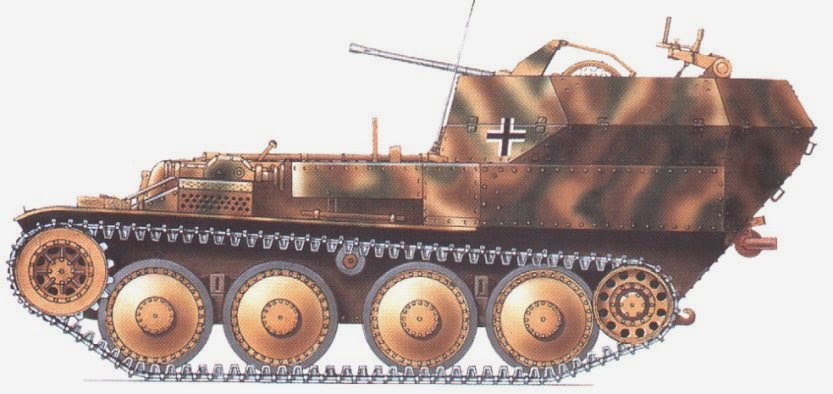Flakpanzer
38(t) auf Selbstfahrlafette 38(t) Ausf M (Sd Kfz 140)
During the autumn of 1943, Hitler approved the
development of a 3.7cm Flakpanzer IV, but refused permission for the
construction of the already available 2cm Vierlings FlaK auf pz Kpfw IV (2cm
Quadruple AA Mounting on AFV IV). On 15 October 1943, because of the urgent
need for a Flakpanzer, Hitler agreed to a makeshift solution which could be
produced immediately on the basis of the Selbstfahrlafette 38(t). 150
Flakpanzer 38(t) were ordered, and were to be produced until the heavier
Flakpanzer IV became available early in 1944. This vehicle was demonstrated to
Hitler on 16 December 1943. Lack of firepower was a major drawback. The last
ten vehicles of the order were used for the production of 15cm s1G33/2 Sf.
2cm FlaK38 with all-round traverse was mounted in the
rear fighting compartment. A new superstructure was provided, the upper part of
which could be folded down to allow easier access to the weapon and permit
traverse at low elevation.
Flakpanzer
IV/3.7cm FlaK
On 18 August 1944, an order for 100 Ostwind (east
wind) was placed, after successful trials had been held in July. Replacing the
Wirbelwind, Ostwind I provided the Panzer troops with the more effective 3.7cm
FlaK43. Both Ostwind I and the M6belwagen were to be replaced by Kugelblitz,
but because of delays, only two Kugelblitz were produced, and seven of the
chassis were used to produce Ostwind I.
A six-sided open-topped turret was mounted, in place
of the normal turret, on converted Pz Kpfw IV chassis. The turret could be
traversed 360° to bring fast, effective fire on air or ground targets.
2cm
Flakvierling 38 auf Fahrgestell Zugkraftwagen 8t (Sd Kfz 7/1)
The basic Zgkw 8t was built by Krauss-Maffei, Borgward
and, from 1943, by Saurer. The FlaK vehicle was built with a special
superstructure which formed an adequate platform for all-round traverse if 1he
sides were folded down. Ammunition was carried in a special single-axle
trailer. The 3.7cm FlaK36 was mounted on the Zgkw 8t from 1943, after
production of the 5t Zgkw ceased.
From late 1943, the driver's cab and engine
compartment of some vehicles were lightly armoured. Vehicles mounting the FV38
towed a Sonder Anhanger (special trailer) 56 to hold the 2cm ammunition, and
for the 3.7cm FlaK, the trailer was the Sd Anh 57. The FlaK36 was given an
anti-tank capability when it was equipped with a muzzle-loading 15cm, hollow
charge, 3 cm Stielgranate 41.
Flakpanzer
IV/ 2cm Vierling
The Wirbelwind was developed as a mount for
anti-aircraft guns on Pz Kpfw IV chassis which had been returned from the front
for major overhaul. They were intended to supplement production of the Möbelwagen. In the autumn of 1944, production of the Wirbelwind
ceased, since the 2cm Flakvierling was not proving as effective as the 3.7cm
FlaK.
The turret was removed from normal Pz Kpfw IV and
replaced by an open-topped turret, in which the Flakvierling 38 was mounted.
Some vehicles had only 50mm frontal armour since early Ausf F to G were
converted for use as the chassis.
As the forces of the Luftwaffe declined to
an increasingly inferior position, close cooperation with air-defense forces
(Flugabwehr) became ever more important. The air-defense platoons
(Fliegerabwehrziige) of the battalions were inadequate in numbers and could
basically provide only point coverage. The supply units often had to be given
priority in that regard. Depending on the situation, the battalion was
occasionally assigned a light antiaircraft battery (Flak-Batterie) from the
division (for example, while forming a bridgehead).
In choosing a position, the air-defense
forces have priority so as to obtain optimal effectiveness. They are assisted
by the battalion in providing their own security.
In the event of an enemy aerial attack, all
tanks also engage the aircraft with their antiaircraft machine guns. If the
formation is in an assembly area or in a position that has not been discovered
by the enemy, it is advisable that it NOT open fire on enemy aircraft that are
merely flying past or overhead. That form of fire control is called weapons
hold (Feuerverbot). If the enemy aircraft attack, fire is immediately opened
and without orders. That also holds true during the form of fire control known
as weapons tight (Feuervorbehalt). In the case of weapons tight, the commander
retains command over opening fire, for example, to coordinate the commitment of
several weapons.
Attacks by aircraft or the sighting of
aircraft flying past are reported as an alarm over the radio. The report
contains data on direction of flight and number of aircraft. For that, no
time-consuming radio call-up procedure is needed. All the information is given
openly in clear text, including locations.




No comments:
Post a Comment